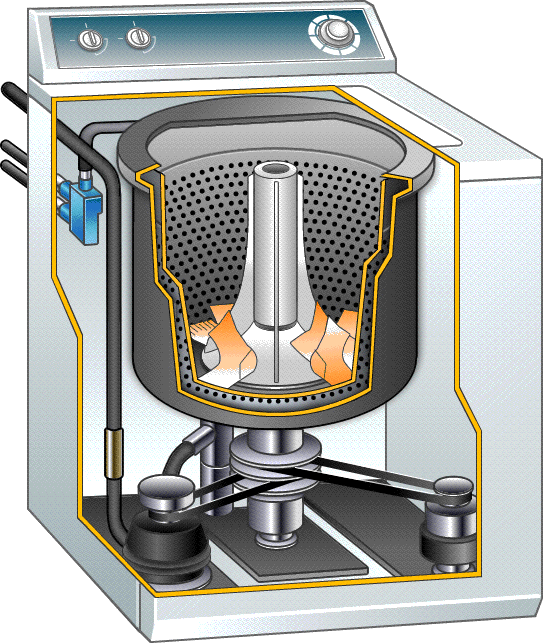Appliance Parts
- Accessories
- Dishwasher
- Dryer
- Stove / Oven
- Microwave
- Refrigerator
- Washer
- See more... See less...
Lawn Equipment Parts
- Lawn Mower
- Chainsaw
- Blower
- Generator
- Air Compressor
- Lawn Tractor
- Pressure Washer
- See more... See less...
Animation: How A Washer Works
By Steve Ash
Day after day we burden our washing machines with big loads of dirty laundry and instead of complaining, they simply get to work giving back nothing but fresh and clean clothes in return. Impressive to say the least!
We know the basics about how they do this, but have you ever wondered what exactly is going on during a full-cycle of a washing machine? In order to satisfy curious minds we decided to take a peek under the lid and put together this animation of a behind the scenes look at a washing machine in action. Check it out for yourself and if you find it as cool as we do, please share it with your friends!
Hover over the parts to see labels!

Embed the image on your site
Load & Filling Selection:
After the laundry is placed in the inner tub, the washing process is started by selecting the timer knob (normally the largest dial), which controls the type and length of the wash cycle. Certain models may also include other dials such as water temperature, spin speed, timer cycle, and laundry size.
Wash & Agiation Cycle:
As our animation begins, the timer knob has sent a signal to the water inlet valve which releases the water into the inner tub via a water hose. Once the inner tub is filled, it begins the spin cycle and small holes in the inner tub allow water to flow into the outer tub, which remains stationary. Water is now mixed with detergent and the cleaning process starts.
After the initial spin cycle is complete, the timer knob sends a signal to the motor to begin the agitation process. The motor is located at the bottom of the washer (under the tub) where it sits on top of the motor pulley. The motor pulley is connected to the drive pulley via the drive belt. When the wash cycle starts, the drive belt loops in a clockwise motion and causes the transmission to turn clockwise and counter clockwise.
Sitting on top of the transmission is the washer's agitator which is found inside the inner tub. The agitator has large fins that quickly move from left to right. This action pushes the water out towards the edge of the tub, up the side of the drum and then back towards the center to the agitator. This process repeats, causing the clothes to rotate in the tub. As you can see in the animation, the clothes that are on the bottom are pushed towards the top and vice versa. The agitator regularly changes direction because if it did not the water/clothes would spin away from agitator.
After the wash cycle is complete, you can see that the water is pumped out of the tub by the washer's water pump. The washer's driver belt is connected to the washer's pump pulley at the bottom of the washer. The belt spins clockwise which starts the pump which uses air pressure to push the water out of the inner tub through the washer's drain hose and out of the house.
Rinse Cycle:
The washer then refills with water and the process of the wash cycle repeats, just without detergent. If fabric softener is used it is released during the rinse cycle via the fabric softener dispenser. It is released using centrifugal force. The spinning action from the agitator causes the fabric softener to rise up and escape the dispenser into the inner tub.
Spin Cycle:
In the last cycle the washer's motor pulley activates the belt connecting the two and it turns on transmission pulley. The transmission starts spinning and this causes the inner tub and the clothes to spin clockwise to remove the excess water.
The washer turns off and clothes are now clean.
- Search your model number to find:
- Genuine OEM parts guaranteed to fit
- Free manuals and guides
- Repair instructions and videos

































